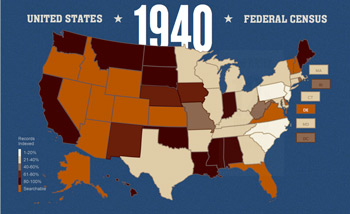The following article is courtesy of Harper Anderson & FamilySearch.org:
With the recent release of the 1940 Census there’s never been a better time to start discovering your family history. But with over 3.8 million digitized 1940 census data sheets to deal with, finding online information on a relative among the 132 million Americans accounted for in the census can seem a daunting task. Soon, due to the efforts of well over 100,000 volunteers, the census data will be indexed, making it very simple to conduct a family search by name. In the meantime, if you have the 1940 street address of a parent, grandparent or great grandparent, a wealth of information may await you, as the address will lead you to the digitized records of the enumeration district they lived in when the census was taken. If you don’t have an ancestor’s address—but you have a little patience and the desire to do some detective work—you should be able to find the street where they lived. Here’s a look at 3 proven ways to find an ancestor’s address at the time of the 1940 Census.
1. Ask a living relative:
Hopefully, one of the biggest benefits of the 1940 Census will be that it better connects us to our living relatives who were around when the census was taken. Again, we’re talking parents, grandparents, and great grandparents, and it’s very possible that they could provide you with an address remembered, or written in a journal, or on and old envelope that has somehow survived those many decades. The key is to ask them, and to do it while you still can. Even if you don’t get the address you seek, you may gain a greater appreciation for your family line through the stories of life in the “good ol’ days” that your question may conjure up.
2. Consult a city directory:
If you know the state and city where your ancestor lived in 1940, there’s a good chance that you can find their street address in a city directory. Past city directories are typically kept on microfilm or in hardbound books which are often kept at local libraries—although many have been digitized and are available on the internet. The information on individuals contained in city directories usually includes a name, occupation, and a complete street address, which is exactly what you need to make use of the 1940 Census. To find a 1940 directory for a city out of your area, you may need to contact other resources such as state and university libraries, historical societies, or state and national archives.
3. Search other sources:
Aside from city directories there are numerous sources which may contain the address of the ancestor you seek. Among the main records to search are birth and death records, state and federal census records—especially the 1930 Census—family histories, journals, naturalization records, newspaper articles, and obituaries. And be sure to go through old photographs in family albums as they might yield valuable clues that could lead you to the street address that unlocks hidden family treasures in the 1940 Census.

I am working on creating a blog + a family tree. It seems like, everything is much easier in your country to do the research in your country.
Where I am from, from top to bottom the bureaucracy is corrupted and we don’t really have a real resources to go back and find out much. I think the best option for me is to ask around the living persons. .